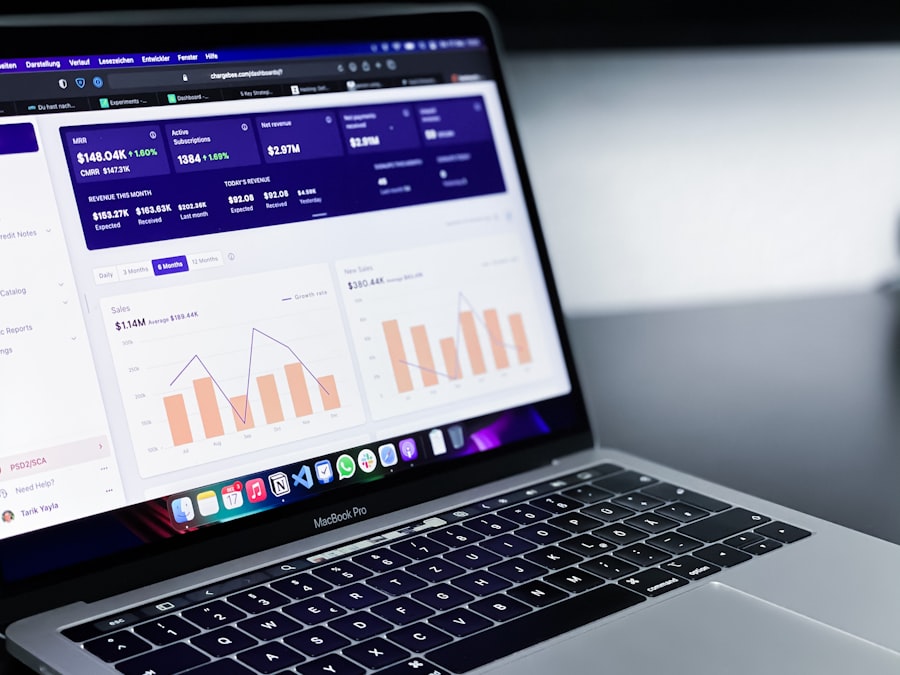Understanding your target audience is the cornerstone of any successful marketing strategy. It involves identifying the specific group of consumers who are most likely to be interested in your products or services. This process begins with demographic analysis, which includes age, gender, income level, education, and geographic location.
However, delving deeper into psychographics—such as interests, values, and lifestyle choices—can provide a more nuanced understanding of your audience. For instance, a company selling eco-friendly products may find that their target audience is not only environmentally conscious but also values sustainability and ethical consumption. By creating detailed buyer personas that encapsulate these characteristics, businesses can tailor their marketing efforts to resonate more effectively with potential customers.
Moreover, understanding your target audience extends beyond mere demographics and psychographics; it also involves recognizing their pain points and motivations. What challenges do they face that your product or service can solve? What drives their purchasing decisions?
Conducting surveys, interviews, and focus groups can yield valuable insights into these areas. For example, a software company might discover that its target audience prioritizes user-friendliness and customer support over advanced features. This information can guide product development and marketing messaging, ensuring that the company addresses the specific needs and desires of its audience.
By continuously engaging with and analyzing your target audience, you can adapt your strategies to remain relevant in an ever-changing market landscape.
Key Takeaways
- Understanding your target audience is crucial for effective marketing strategies
- SEO strategies help improve your website’s visibility on search engines
- Social media marketing allows you to engage with your audience and build brand awareness
- Email marketing campaigns can be personalized and targeted for better results
- Content creation and blogging are essential for providing valuable information to your audience
- PPC advertising can drive targeted traffic to your website for immediate results
- Website analytics and tracking help measure the success of your marketing efforts
- Mobile marketing strategies are important for reaching users on their mobile devices
Search Engine Optimization (SEO) Strategies
Keyword Research: The Foundation of SEO
One of the fundamental strategies in SEO is keyword research, which involves identifying the terms and phrases that potential customers use when searching for products or services similar to yours. Tools like Google Keyword Planner and SEMrush can help marketers uncover high-volume keywords with manageable competition. By strategically incorporating these keywords into website content, meta descriptions, and headers, businesses can improve their chances of ranking higher in search results.
On-Page SEO: Enhancing User Experience
In addition to keyword optimization, on-page SEO plays a vital role in enhancing user experience and engagement. This includes optimizing page load speed, ensuring mobile-friendliness, and creating a clear site structure with intuitive navigation. For instance, a retail website might implement breadcrumb navigation to help users easily trace their steps back through categories and subcategories.
Content Quality and Off-Page SEO
Furthermore, high-quality content that provides value to users is essential for SEO success. Search engines prioritize content that answers users’ queries effectively, so creating informative blog posts, how-to guides, and product descriptions can significantly boost a site’s authority and relevance. Off-page SEO strategies, such as building backlinks from reputable sites and engaging in social media promotion, further enhance a website’s credibility and visibility.
Social Media Marketing

Social media marketing has transformed the way businesses interact with their customers and promote their products or services. Platforms like Facebook, Instagram, Twitter, and LinkedIn offer unique opportunities for brands to engage with their audience in real-time. One of the key advantages of social media marketing is its ability to foster community and build relationships.
Brands can use social media to share behind-the-scenes content, respond to customer inquiries, and showcase user-generated content. For example, a fashion brand might encourage customers to share photos of themselves wearing its products using a specific hashtag. This not only creates a sense of community but also serves as authentic testimonials that can influence potential buyers.
Moreover, social media advertising allows businesses to reach highly targeted audiences based on demographics, interests, and behaviors. Platforms like Facebook offer robust ad targeting options that enable marketers to tailor their campaigns to specific segments of their audience. For instance, a local coffee shop could run ads targeting individuals within a certain radius who have shown interest in coffee-related content.
Additionally, social media analytics tools provide valuable insights into engagement metrics such as likes, shares, comments, and click-through rates. By analyzing this data, businesses can refine their social media strategies to focus on the types of content that resonate most with their audience.
Email Marketing Campaigns
| Campaign Name | Open Rate | Click-Through Rate | Conversion Rate |
|---|---|---|---|
| Spring Sale | 25% | 10% | 5% |
| Summer Promotion | 30% | 12% | 6% |
| Back to School | 28% | 11% | 5.5% |
Email marketing remains one of the most effective channels for reaching customers directly and fostering long-term relationships. Unlike social media or paid advertising, email allows for personalized communication that can be tailored to individual preferences and behaviors. Building an email list is crucial; businesses can encourage sign-ups through website pop-ups, exclusive offers, or valuable content downloads.
Once a list is established, segmenting it based on customer behavior—such as past purchases or engagement levels—can enhance the effectiveness of email campaigns. For example, an e-commerce store might send targeted promotions to customers who have previously purchased similar items or abandoned their shopping carts. Crafting compelling email content is essential for capturing attention in crowded inboxes.
Subject lines should be engaging yet concise to encourage opens, while the body of the email should provide value—whether through informative content, special offers, or personalized recommendations. A/B testing different elements of emails—such as subject lines, images, or call-to-action buttons—can help marketers identify what resonates best with their audience. Additionally, tracking metrics like open rates, click-through rates, and conversion rates allows businesses to assess the effectiveness of their campaigns and make data-driven adjustments for future emails.
Content Creation and Blogging
Content creation is at the heart of digital marketing strategies and serves as a powerful tool for attracting and engaging audiences. Blogging is one of the most effective ways to produce valuable content that addresses the interests and needs of your target audience. By consistently publishing informative articles on topics relevant to your industry or niche, businesses can establish themselves as thought leaders while improving their SEO rankings.
For instance, a health and wellness brand might create blog posts about nutrition tips or workout routines that not only provide value but also incorporate relevant keywords to enhance search visibility. Moreover, diverse content formats—such as videos, infographics, podcasts, and webinars—can cater to different audience preferences and learning styles. A company might create an infographic summarizing key statistics related to its industry or produce a podcast featuring interviews with experts in the field.
This variety not only keeps the audience engaged but also encourages sharing across different platforms. Additionally, repurposing existing content into different formats can maximize reach; for example, turning a popular blog post into a video tutorial can attract new audiences who prefer visual content.
Pay-Per-Click (PPC) Advertising

Pay-Per-Click (PPC) advertising is a powerful digital marketing strategy that allows businesses to drive targeted traffic to their websites through paid ads on search engines and social media platforms. The primary advantage of PPC is its ability to generate immediate visibility; unlike organic search efforts that may take time to yield results, PPC campaigns can start driving traffic as soon as they are launched. Google Ads is one of the most popular platforms for PPC advertising, enabling businesses to bid on keywords relevant to their offerings.
Effective PPC campaigns require careful planning and ongoing optimization. Marketers must conduct thorough keyword research to identify high-performing keywords while also considering negative keywords—terms for which they do not want their ads to appear.
Ad copy should be compelling and relevant to encourage clicks while aligning with landing page content for a seamless user experience. Additionally, monitoring key performance indicators (KPIs) such as click-through rates (CTR), conversion rates, and return on ad spend (ROAS) is essential for assessing campaign effectiveness. By analyzing this data regularly, marketers can make informed adjustments to bidding strategies, ad placements, and targeting options.
Website Analytics and Tracking
Website analytics and tracking are integral components of any digital marketing strategy as they provide insights into user behavior and campaign performance. Tools like Google Analytics allow businesses to monitor various metrics such as website traffic sources, user demographics, bounce rates, and conversion rates. Understanding where visitors come from—whether through organic search, social media referrals, or direct traffic—enables marketers to allocate resources effectively across different channels.
For example, if analytics reveal that a significant portion of traffic comes from social media platforms but has a high bounce rate, it may indicate that the landing page needs optimization or that the messaging does not align with user expectations. In addition to tracking overall website performance, setting up goals within analytics tools helps businesses measure specific actions taken by users—such as completing a purchase or signing up for a newsletter. This data is invaluable for assessing the effectiveness of marketing campaigns and identifying areas for improvement.
A/B testing different elements on landing pages—such as headlines or call-to-action buttons—can also be informed by analytics data to determine which variations lead to higher conversion rates. By leveraging analytics effectively, businesses can make data-driven decisions that enhance user experience and drive better results.
Mobile Marketing Strategies
With the increasing prevalence of smartphones and mobile devices in everyday life, mobile marketing has become an essential aspect of digital marketing strategies. Mobile marketing encompasses various tactics aimed at reaching consumers on their mobile devices through channels such as SMS messaging, mobile apps, responsive web design, and location-based marketing. One key strategy is optimizing websites for mobile use; ensuring that sites are responsive allows users to navigate seamlessly regardless of device type.
A study by Google found that 53% of mobile users abandon sites that take longer than three seconds to load; thus, optimizing load times is crucial for retaining visitors. Additionally, SMS marketing offers a direct line of communication with customers who opt-in to receive text messages from brands.
Location-based marketing leverages GPS technology to send targeted promotions or notifications when users are near physical store locations. For instance, a retail store might send an exclusive discount code via SMS when customers are within a certain radius of the store—a tactic that encourages foot traffic while providing added value to consumers. In conclusion, each element discussed plays a vital role in creating an effective digital marketing strategy tailored to meet the needs of your target audience while leveraging various channels for maximum impact.
Digital marketing tools play a crucial role in helping businesses reach their target audience effectively. One related article that highlights the importance of technology in the business sector is Equinix partners with GIC and CPP Investments for major data centre expansion. This article discusses how Equinix, a leading data center provider, is partnering with major investment firms to expand its data center infrastructure, which will ultimately support the growing demand for digital services and technologies. This partnership showcases the significance of investing in technology infrastructure to support the digital transformation of businesses and industries.
FAQs
What are digital marketing tools?
Digital marketing tools are software or platforms that help businesses and marketers to create, manage, and optimize their online marketing efforts. These tools can include social media management, email marketing, search engine optimization (SEO), content marketing, and analytics.
What are some common digital marketing tools?
Some common digital marketing tools include Google Analytics, Hootsuite, Mailchimp, SEMrush, Buffer, Ahrefs, Canva, and HubSpot. These tools help with various aspects of digital marketing such as social media management, email marketing, SEO, content creation, and analytics.
How do digital marketing tools help businesses?
Digital marketing tools help businesses by providing them with the means to reach and engage with their target audience more effectively. These tools can automate marketing processes, provide valuable insights and data, improve campaign performance, and ultimately drive more leads and sales for the business.
Are digital marketing tools expensive?
The cost of digital marketing tools can vary widely depending on the specific tool and the features it offers. Some tools offer free versions with limited features, while others may require a monthly subscription or a one-time purchase. It’s important for businesses to evaluate the cost and potential return on investment when considering digital marketing tools.
Do businesses need to use digital marketing tools?
While it’s possible to execute digital marketing efforts without the use of specific tools, using digital marketing tools can greatly enhance a business’s marketing strategy. These tools can streamline processes, provide valuable data and insights, and help businesses stay competitive in the digital landscape.












